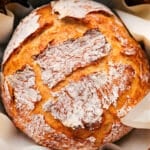No-Knead Bread
No-Knead Bread is the ultimate easy artisan-style loaf. With simple ingredients and minimal effort, you’ll get perfect, bakery-worthy results every time!
Servings: 12 slices
Cost: $3.42
Equipment
- Cast-iron pot with lid 5.5-quart (or larger), see note 1
Ingredients
Instructions
- In a medium bowl, whisk together yeast, honey, and warm water. Let it sit for 5 minutes until creamy or foamy. If the mixture doesn’t foam, the yeast may be dead, or the water might have been too hot. Start again if this happens.
- In a large mixing bowl, mix together flour and salt using a rubber spatula. Add the yeast mixture to the flour mixture and stir until a shaggy dough forms with no dry flour streaks. Use the spatula to pull the dough to one side and drizzle in the olive oil. Turn the dough to coat it in the oil (it will be sticky). Cover the bowl fully with plastic wrap.
- Let the dough rest overnight at room temperature (around 70°F / 21°C) for 10–18 hours. For a quicker option, see note 4.
- Move an oven rack to the center position and preheat oven to 450°F (230°C). Place the cast-iron pot (with lid) in the oven to heat for 30 minutes.
- Sprinkle 1 tablespoon of flour on a clean work surface. Use a spatula to scrape the dough out of the bowl onto the floured surface. Sprinkle 1 more tablespoon of flour on top. Gently fold the sides inward with a spatula or dough scraper, making 6 folds to form a rough ball. Transfer the dough ball onto a large piece of parchment paper, flipping it upside down so the seam side is down. Gently shape it into a rough ball. (Optional: Score the top with 3–5 slashes if you have a lamé).
- Carefully remove the heated pot from the oven, lift the parchment paper with the dough, and place it into the pot. Cover with the lid and bake for 30 minutes. Then, remove the lid and bake an additional 12–18 minutes, until the bread sounds hollow when tapped in the center and the top is a deep golden brown.
- Carefully remove the bread from the pot using the parchment paper, and slide it onto a wire cooling rack. Let it cool for a full 30 minutes before slicing with a sharp serrated knife (see note 5).
Video
Notes
Note 1: Here is a great affordable cast-iron pot, and here is my favorite pot! For alternatives to a cast-iron pot, see the post.
Note 2: Ensure you use parchment paper, not foil or wax paper, as wax paper will melt in the oven.
Note 3: Test the water temperature by drizzling a few drops on your wrist. It should feel warm and comfortable, not hot.
Note 4: No-Knead Bread In a Hurry: After 2–3 hours, you can bake the bread immediately. The flavor and texture won’t be as developed as after a long rest but will still be tasty.
Note 5: Allowing the bread to cool is crucial to ensure it’s fully baked inside. Cutting too early can result in a mushy interior.
Storage: This bread is best on days 1 and 2. On the first day, leave it out uncovered with the cut side down on a cutting board to keep the crust crisp. After that, store it in an airtight container or bag. The crust may lose its crispness, but the bread will still be great toasted.
Nutrition
Serving: 1serving | Calories: 117kcal | Carbohydrates: 23.8g | Protein: 3.2g | Fat: 0.7g | Sodium: 194.4mg | Fiber: 0.8g | Sugar: 0.1g
